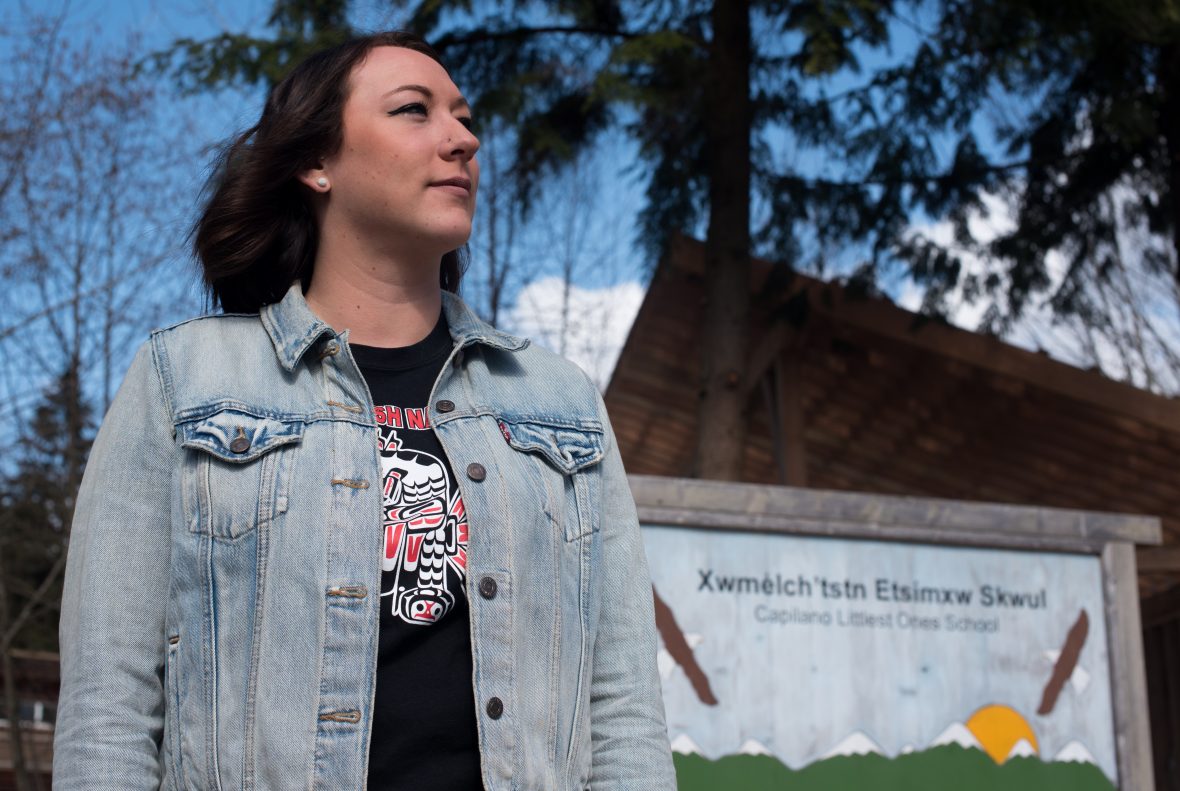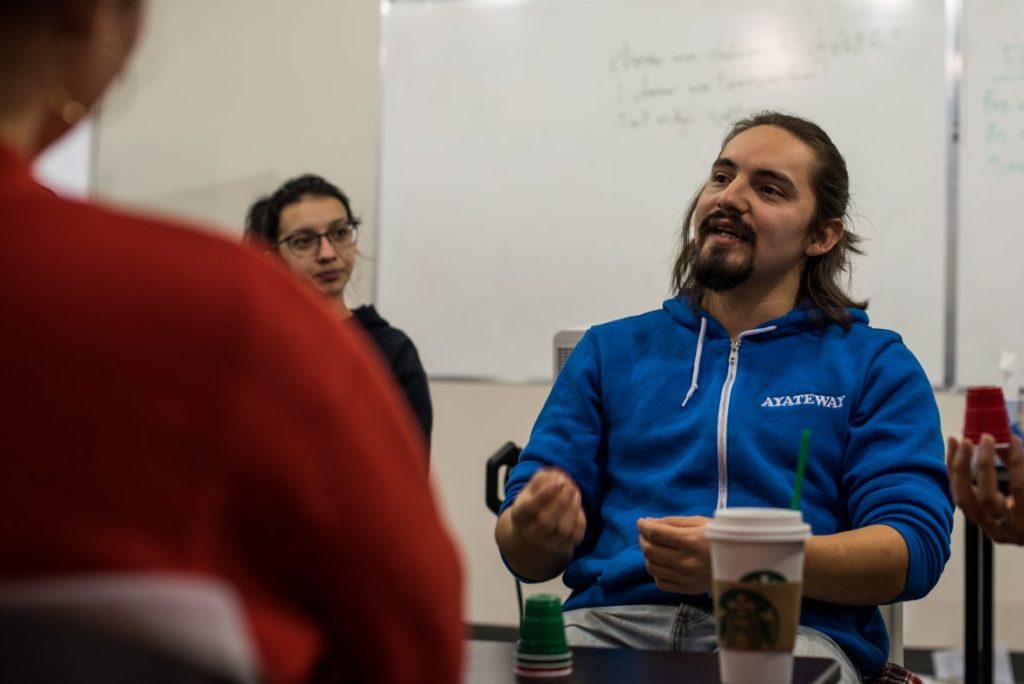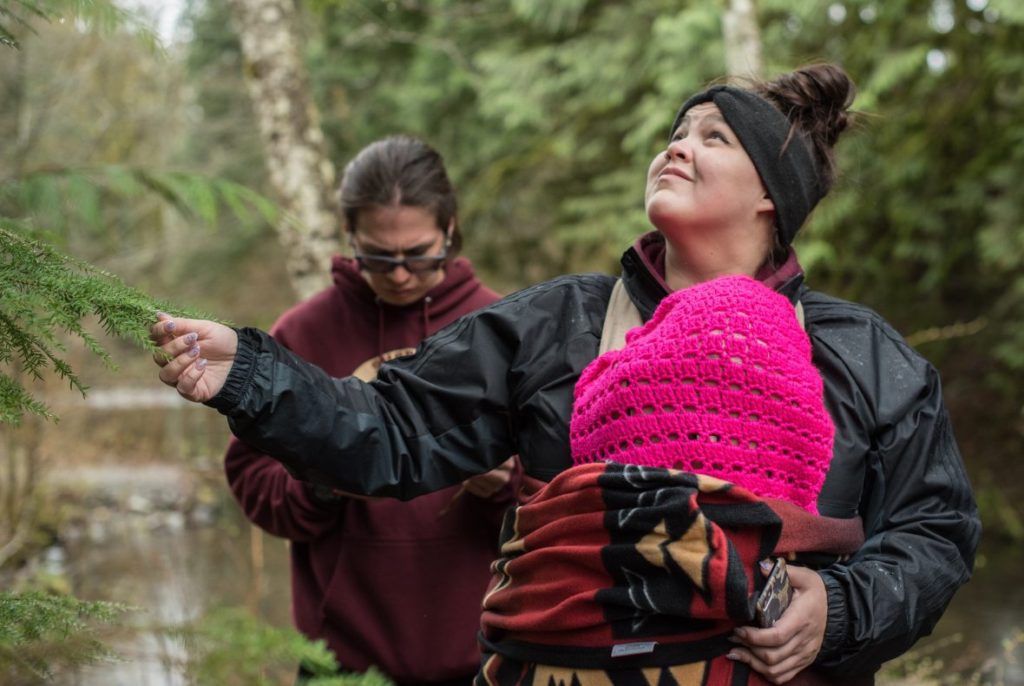
By Dustin Patar and Marc Fawcett-Atkinson
Four years ago, a report on the status of B.C. First Nations languages listed Sk̲wx̱wú7mesh sníchim, the Skwomesh language in English, as ‘critically endangered,’ having only seven fluent speakers remaining.
But that isn’t the case anymore.
Passerbys walking through Simon Fraser University’s downtown Vancouver campus over the last academic year might have been lucky enough to overhear a small group of people conversing in Skwomesh.
Those speakers were students enrolled in the second cohort of an immersive Skwomesh language course, co-offered by SFU and the Squamish language non-profit Kwi Awt Stelmexw. They graduated last month.
But leaving the immersive classroom environment behind presents their biggest challenge yet. Swo-wo Gabriel (Billy), who graduated in the first cohort a year ago, knows this all too well.
“It’d be easier if there was more language in our daily lives.”
The problem is that, even among the Squamish Nation’s 6000 members, there are only a handful of skilled speakers. Beyond the small community, the language is mostly drowned out in a sea of English. That’s a situation the graduates themselves will need to change.

Creating more speakers
For Swo-wo, using Skwomesh in daily life first involves using it at home.
“Our main goal is just to get language, our Skwomesh language, to start being spoken in the homes. At home. With kids. With families.”
To do this, he surrounds his two-year old daughter with as much Skwomesh as possible. Bedtime stories are a good place to start.
“My daughter loves reading children’s books,” he says. “I translate (from English to Skwomesh) when I read her books.” His daughter can’t read yet, but enjoys looking at the pictures and hearing Skwomesh. Swo-wo expects she’ll be reading for herself soon, and he’s hoping to work with an illustrator to develop Skwomesh children’s books ready for her when she does.
But Swo-wo hasn’t left the classroom fully behind.
After graduating, he was selected to become a teaching assistant for the second cohort. That’s meant he’s been able to work immersed in the language, a major draw to the job.
“The main reason I said yes wasn’t to teach new people, it was to create more speakers that I could talk with.”
But for others in last year’s cohort, including Carey McReynolds, the opportunity to be fully immersed in the language is rare.
A conversation with somebody
McReynolds is a teacher at the Capilano Little Ones School, an elementary school run by the Squamish Nation. Born in Alberta, she moved to her mother’s reserve in North Vancouver during high school. It was there she started learning more about Skwomesh language and culture. Taking the Skwomesh immersion class was a natural continuation of her learning.
Being isolated from other speakers has been her biggest challenge since graduating. She doesn’t get many opportunities to spend time talking with the few other Skwomesh speakers in the community. While she teaches her young students some Skwomesh, they’re unable to maintain long or complex conversations.
“I’m teaching simple words right now, not enough to stay sharp in the language,” she says.
The feeling of isolation isn’t unique to McReynolds. Even Char George, Swo-wo’s co-teacher in the immersion program, has struggled with language loneliness.
“I went crazy last year, I didn’t feel like I had anybody to talk to,” says George.
“Then I would listen to the recordings and my co-worker would laugh. She’d be like “It sounds like you’re having a conversation with somebody.” I would talk back-and-forth if I just had headphones on, which is cool because it’s my late great-uncle I was listening to. “
Ripple effect
Last month, another 15 Skwomesh language speakers left the classroom behind, raising the number of program graduates to 30. That number doesn’t factor in pre-existing speakers and children now being taught Skwomesh as a first language at home.
Kwi Awt Stelmexw, the non-profit behind the program, hopes that by 2028 there will be over 170 fluent Skwomesh speakers.
According to Swo-wo, those speakers will be at the forefront of the language’s reawakening.
“I can’t tell a lawyer what language he needs to use in Skwomesh: a lawyer needs to get fluent and figure it out. We need more people from different walks of life to become fluent. That will bring out more language we haven’t used in a long time.”
Char George likes to think of the language’s growth using a metaphor.
“We’re that pebble that got thrown in and made the ripple, and now it’s just like going out to the community and they’re starting to see it. They’re starting to feel that ripple effect now.”
That ripple is spreading quickly. According to George, there’s plenty of interest in next year’s program, particularly from youth, which is good news for those striving to speak Skwomesh beyond the classroom.
“I’d love if there was a lot of young people next year, then they have the whole rest of their lives to learn.”
.

About the authors
Marc Fawcett-Atkinson is a writer and reporter with an interest in land, people, and cold places. Follow him on Twitter: @marcfawat
Dustin Patar is a journalist, photographer and storyteller focused on the environment and our place in it. Follow him on Twitter: @DustinPatar

